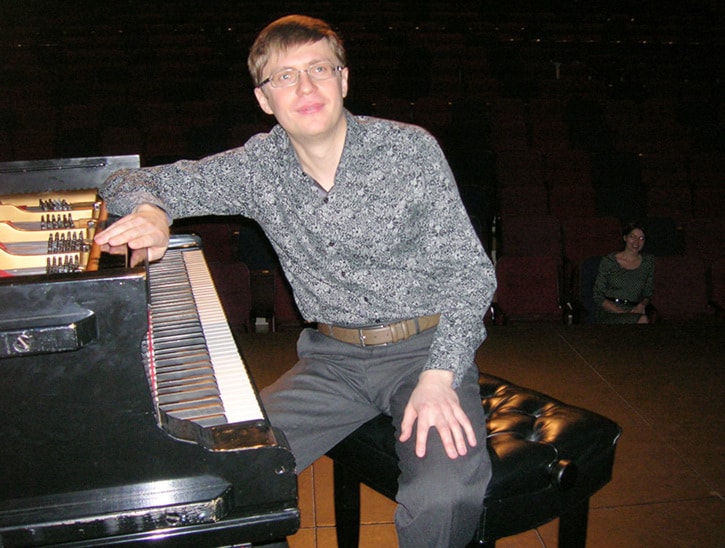Sunday afternoon saw the swan song of the North Okanagan Community Concert Association’s 1887 Steinway piano.
It was grand.
NOCCA president Paul Maynes announced that all the keys on the association’s virtual piano, raising funds toward the cost of the association’s replacement Steinway, had been sold. Only two of its three pedals remained.
When Maynes introduced the curtain raiser, a young lady of poise, grace, talent and charm took her seat at the majestic old instrument. Megan Van Den Maagdenberg, whom some may have enjoyed at NOCCA’s youth showcase last month, played her own composition, Gentle Defenestration (roughly translated as a gentle push out of a window), and proceeded to accompany herself singing two lovely songs, A Fine, Fine Line and Samson in a clear voice as pure as water tumbling down BX Creek.
She promised an evening of bliss.
And pianist Sergei Saratovsky delivered. As if in response to my review of his 2013 visit, when I’d criticized his speaking style, he introduced the pieces from a podium, reading from witty, insightful notes in a melodiously thick Russian accent while he saved his hands for his virtuoso performance.
It opened sublimely with two of the 555 sonatas composed by Domenico Scarlatti. The first, in E Major (K.380), still resonates. Its playful successor in G Major (K.146) rippled over the keyboard in response to Saratovky’s rejuvenating touch.
Frédéric Chopin’s famous Minute Waltz followed. If the emphasis is placed on the second rather than the first syllable, minute becomes “minute” (as in “tiny”) and seems a more apt subtitle to Valse in D Flat Major Opus 64 No. 1, particularly as even speedy Saratovsky and precise Streisand, in her Colour Me Barbra sung version, can’t come in under two minutes.
Saratovsky’s segue into Chopin’s second popular waltz in Opus 64, was as seamless as his segue from one Scarlatti sonata to another, as well as those between Anatoly Lyadov’s five preludes in the program’s second half.
Claude Debussy wrote L’isle joyeuse (The Joyful Island) in 1904 when he fell in love on, and with, Jersey, an island in the English Channel. We fell in love too when Saratovsky’s expressive passion conjured pictures of gulls swooping, sun gleaming and waves crashing.
Our dramatic pianist rose breathlessly from Debussy’s climactic ending to introduce Franz Liszt’s Liebestraum (Dream of Love). He explained Liszt’s three concepts of love: religious, erotic and unconditional, saying, “Liebestraum is a definitive illustration of the latter.” Then he went on to prove it.
His mastery of all aspects of music was manifested in Liszt’s Fantasia quasi Sonata, written after a reading of Dante’s Divine Comedy. When Saratovsky’s interpretation of hell, purgatory and paradise ended, my neighbour sighed, “Now I believe in aliens. This man’s superhuman.”
The second half of the program required more work from the audience.
Tchaikovsky’s Dumka (Russian Village) evoked images of cold streets and worn faces. Relief came with Lyadov’s five preludes and a loving anecdote about his laziness.
Lyadov’s magical Music Box also provided a perfect encore to the program which ended with Sergei Rachmaninoff’s mighty Sonata No. 2 in B Flat Minor Opus 36. Even though this was the shorter version, rewritten in 1931 when Rachmaninoff was 58, its meaty variations between the explosive and lyrical left us, the piano and Saratovsky exhausted.
Apart from this final tour de force, every piece in the program was written when its composer was in his 30s or 40s (including Rachmaninoff’s original manuscript), to contrast our fond, grateful adieu to NOCCA’s much older Steinway.
– Christine Pilgrim reviews the North Okanagan Community Concert Association's season for The Morning Star.
